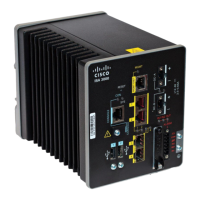• A number-2 Phillips screwdriver.
Ethernet Devices
Identify the Ethernet devices that you will connect to the router: hub, servers, and workstations or PCs. Ensure
that each device has a network interface card (NIC) for connecting to Ethernet ports.
If you plan to configure the software through the console port, provide an ASCII terminal or a PC that is
running terminal emulation software to connect to the console port.
Installing the Cisco ISA 3000
This section describes how to install the Cisco ISA 3000. This device can be installed on a table top or other
flat horizontal surface mounted on a wall or DIN rail.
Airflow around the device must be unrestricted. To prevent the device from overheating, ensure these
minimum clearances:
Caution
• Top and bottom: 1.0 inches (25 mm)
Exposed side (not connected to the module): 1.0 inches (25 mm)
• Front: 1.0 inches (25 mm)
When installing the device, ensure the temperature surrounding the unit does not exceed 140°F (60°C). When
the device is installed in an industrial enclosure, the temperature within the enclosure is greater than normal
room temperature outside the enclosure.
Other guidelines to consider:
• Cabling is away from sources of electrical noise, such as radios, power lines, and fluorescent lighting
fixtures.
• Connect the unit only to a Class 2 DC power source.
• Contact your Cisco TAC if tighter spacings are required.
This section contains the following topics:
Installing a DIN Rail
You can use either the 7.5-mm or the 15-mm thick DIN rail for the Cisco ISA 3000. Secure the DIN rail to
the mounting surface approximately every 7.8 inches (200 mm) and use end-anchors appropriately.
The device ships with a spring-loaded latch on the rear panel for a mounting on a DIN rail. Refer to the
following figure:
Installing the Cisco ISA 3000 Industrial Security Appliance
2
Installing the Cisco ISA 3000 Industrial Security Appliance
Ethernet Devices

